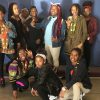On the morning of March 14, nearly 150 Henderson-Hopkins middle schoolers poured into Baltimore’s Flagship Premium Cinemas Eastpoint, buzzing with excitement to see the new Marvel film Black Panther. Some were dressed in costume, wearing all black or traditional African attire. Throughout the movie, students cheered and gasped as they watched their favorite characters battle. “When I first saw it, I thought, ‘Oh my gosh, this is amazing!’” said one eighth-grade student who attended the screening. “The best movie I’ve ever seen.”
It almost didn’t happen.
Sixth-grade teacher D’Ambra Taylor began planning for her students to attend the Black Panther screening months in advance. After seeing the trailer and learning that the movie featured an African American director and leading actors, she decided that it was essential for her students, a majority of whom are African American, to see the movie.
“This kind of representation is important for them to see, especially when it comes to heroes,” Taylor said. After sharing the trailer with her students, she had each of them write a letter to the principal stating why they thought it was important for Henderson-Hopkins students to see the film.
Despite the sixth graders’ campaign, however, the school was having difficulty finding the funding to make the trip possible. Taylor was beginning to consider paying for it out of her own pocket when a real-life hero stepped in.
Former NBA player Keith Booth, who grew up just blocks from Henderson-Hopkins, had spoken at the school’s Parent Teacher Association-sponsored “Storyteller Literacy Night” a few weeks before. Having just seen Black Panther with his 6-year-old son, he was inspired by the movie’s potential to help young African Americans envision themselves as superheroes.
“I thought, ‘Other kids need to see this,’” Booth said. He reached out to the school through the PTA to see if he could take a group of students to see the film, and once he saw the wide level of interest, he decided to sponsor attendance for all 150 middle schoolers.
In preparation for the trip, Henderson-Hopkins teachers began building some of the film’s themes into their curriculum. English teachers had their students do a critical analysis of articles about the film; history teachers talked about colonization; even science teachers discussed the fictional element “vibranium” used in the film. Assistant Principal of Middle School Jerome Graham took the opportunity to challenge students to think about what kind of leaders they want to be by comparing T’Challah and Killmonger.
“You can lead in so many different ways, you can participate in so many different ways,” Graham told the middle schoolers. “So this is a great opportunity for you guys to springboard what your next step is. What’s going to be your role in figuring out how you can impact the world? Y’all will be the leaders of our world soon.”
As the students learned more about the underlying themes running through the movie, they began to use them as inspiration to incorporate what they learned into their own school. The film’s “Wakanda Forever” icon has become a symbol of solidarity within the school community. Some students, for example, inspired by the strong women in the movie, launched a mentoring group at the school for female students.
“They showed the women fighting with the men, and they were winning, so it made me think that anything a man can do, women can do the same,” said an eighth grader who helped to start the mentoring program.
Thanks to the hard work of school staff and the generosity of Keith Booth, Henderson-Hopkins students enjoyed a transformative experience that altered the way they view themselves and the world. As the students look forward to high school, they are continuing to use the sense of inspiration they gained from Black Panther to navigate their futures as young leaders.
“This movie probably changes your life,” said one student, when asked to sum up the experience. “It’s empowering. It sends you a message.”

